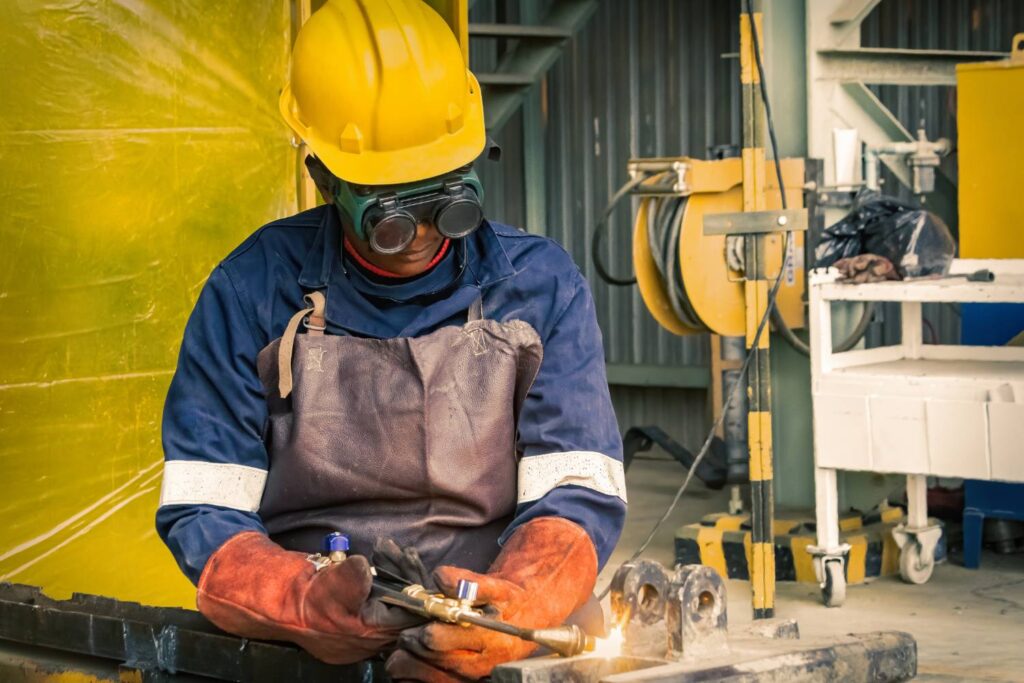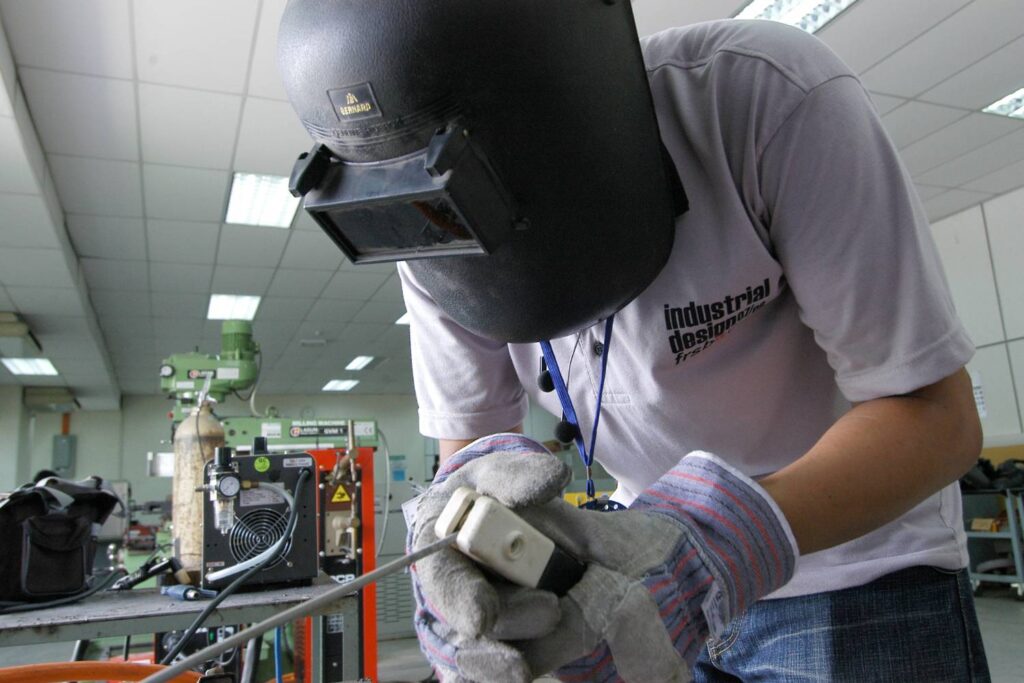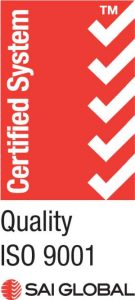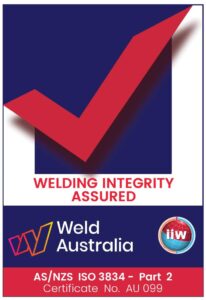This blog explores the most common welding process, a fundamental skill for welders worldwide. Welding is a cornerstone technique in manufacturing and construction, with various processes offering unique advantages.
The blog explores the world of welding, from the forge to modern machinery, to reveal its popularity and the reasons behind its popularity. It is suitable for both experienced and new welders.
Table of Contents
Understanding Welding
Welding, a fundamental process in the construction and manufacturing industries, is the art and science of joining metals and other materials. It involves the application of heat, pressure, or a combination of both to fuse separate pieces into a single entity, ensuring structural integrity and continuity.
This technique is not just about melting metals together; it's a skilled craft that requires understanding material properties, heat control, and joining physics.
At its core, welding is about transformation. It transforms separate pieces of metal into a unified whole, creating bonds often more potent than the joined materials. This process is critical in fabricating everything from household appliances to skyscrapers, vehicles, and space stations. The modern infrastructure and technological advancements we rely on are possible with welding.

Types Of Welding Processes
Welding encompasses a variety of techniques, each suited to different materials and applications:
- Arc Welding: An electrical arc melts metals at the welding point.
- MIG (Metal Inert Gas) Welding: A form of arc welding that uses a continuous wire feed as an electrode and an inert gas to protect the weld pool from contamination.
- TIG (Tungsten Inert Gas) Welding: Known for its precision, TIG welding uses a non-consumable tungsten electrode and is ideal for thin materials.
- Stick Welding: A versatile method that uses a consumable electrode coated in flux to lay the weld.
- Flux-Cored Arc Welding: Similar to MIG welding, it uses a special tubular wire filled with flux.
Importance Of Welding
Welding is indispensable across various sectors. In construction, it provides the framework for buildings and bridges. In manufacturing, it is essential for assembling vehicles and machinery. Welding also plays a crucial role in the energy sector, from constructing pipelines to building wind turbines and solar panels. Moreover, the aerospace and defence industries rely on welding for the structural integrity of aircraft and military equipment.
Welding And Innovation
The welding industry is at the forefront of technological innovation, embracing automation, robotics, and advanced materials. These advancements improve efficiency and quality and open new possibilities for design and construction, pushing the boundaries of what can be achieved.
The Contenders For Most Common Welding Process
Several welding processes stand out for their widespread use and versatility in the diverse metal fabrication and repair world. These processes have evolved, each developed to meet specific needs regarding material compatibility, application requirements, and environmental considerations. Here, we explore the key contenders that have become the industry's most common and preferred welding processes.
Gas Metal Arc Welding (Gmaw/Mig)
GMAW, more commonly known as MIG welding, uses a wire-feeding gun that feeds wire at an adjustable speed and flows an inert gas over the weld puddle to protect it from contamination. MIG welding is praised for its speed, efficiency, and relative ease of use, making it a favourite in industrial fabrication and hobbyist applications.
Shielded Metal Arc Welding (Smaw)
Often referred to as stick welding, SMAW is one of the oldest and most versatile welding processes. It uses a consumable electrode coated in flux to lay the weld. This process is well-suited for outdoor use and is commonly employed in construction projects, pipeline work, and repair jobs due to its simplicity and effectiveness in welding thick materials.
Gas Tungsten Arc Welding (Gtaw/Tig)
GTAW, or TIG welding, is known for the high quality of its welds. It uses a non-consumable tungsten electrode to produce the weld and requires a separate filler material. Ideal for welding thin materials or metals that require precise, high-quality welds, such as stainless steel or aluminium, TIG welding is widely used in the aerospace industry, automotive repair, and artistic metalwork.
Flux-Cored Arc Welding (Fcaw)
Like MIG welding, FCAW uses a special tubular wire filled with flux to protect the arc. This process is often chosen for its flexibility, high welding speed, and penetration. FCAW is particularly effective in construction applications and can weld thicker materials in one pass with less pre-cleaning of the workpiece.
Submerged Arc Welding (Saw)
SAW is a process that uses a continuously fed consumable electrode and a blanket of flux to protect the weld zone from atmospheric contamination. This process is known for its deep weld penetration and high quality, making it ideal for heavy industrial applications such as shipbuilding and large-scale construction projects.
Gas Metal Arc Welding (Gmaw/Mig) - The Most Common Welding Process
Gas Metal Arc Welding (GMAW), commonly known as Metal Inert Gas (MIG) welding, stands as a cornerstone in the welding industry, renowned for its versatility, efficiency, and ease of use. Due to its adaptability to a wide range of materials and applications, This process has cemented its status as the most common welding technique across various sectors, including automotive, construction, and manufacturing.
The Gmaw/Mig Process
GMAW/MIG welding utilizes a continuous solid wire electrode fed through a welding gun into the weld pool, joining two base materials together. An external gas supply shields inert or semi-inert gas to protect the weld pool from atmospheric contamination, ensuring clean, strong welds. This process is characterized by its ability to produce high-quality welds with minimal cleanup, making it a preferred method for professional and amateur welders.
Advantages Of Gmaw/Mig Welding
Advantages Of Gmaw/Mig Welding
- Versatility: GMAW/MIG can be used with various metals and alloys, including carbon steel, stainless steel, aluminium, and more.
- Ease of Use: The continuous wire feed and automatic shielding gas make it easier to learn and master than other welding processes.
- Efficiency: High welding speeds can be achieved, making it suitable for both small projects and large-scale industrial applications.
- Cleanliness: Shielding gas minimizes slag formation, resulting in cleaner welds that require less post-weld cleaning.
Applications Of Gmaw/Mig Welding
Applications Of Gmaw/Mig Welding
GMAW/MIG's versatility makes it suitable for various applications, from simple home repairs to complex industrial fabrication tasks. It's widely used in the automotive industry for repairing and manufacturing vehicle components, construction for structural framing and manufacturing for creating a vast array of metal products.
Technical Considerations
While GMAW/MIG is user-friendly, achieving optimal results requires an understanding of several technical aspects, including:
- Selection of Shielding Gas: The choice of gas can affect the weld's characteristics, with argon and carbon dioxide being common choices for different materials and desired outcomes.
- Welding Parameters: Adjusting the voltage, amperage, and wire feed speed is crucial to accommodate different materials and thicknesses.
- Equipment Maintenance: Regular maintenance of the welding equipment ensures consistent performance and high-quality welds.
Learning And Mastering Gmaw/Mig Welding
Embarking on the journey to learn and master Gas Metal Arc Welding (GMAW), commonly known as MIG welding, is exciting for many aspiring welders. This process, renowned for its versatility and efficiency, is a staple in industrial settings and hobbyist workshops. Here, we outline a comprehensive guide to learning GMAW/MIG welding and mastering the techniques to elevate your welding skills.
Starting With The Basics
Understanding the fundamentals of GMAW/MIG welding is the first step towards proficiency. This includes familiarizing yourself with the equipment, which comprises a welding machine, a wire feed unit, a welding gun, and shielding gas—learning about the different types of metals that can be welded with GMAW/MIG, such as carbon steel, stainless steel, and aluminium.
Equipment Setup And Maintenance
Proper setup of your welding equipment is essential for achieving optimal results. This involves selecting the correct wire diameter, adjusting the tension on the wire feed, and choosing the appropriate shielding gas and flow rate. Regular maintenance, including cleaning the gun liner and replacing consumables, ensures consistent performance and longevity.
Mastering Welding Techniques
GMAW/MIG welding requires a steady hand and a keen eye for detail. Practice is vital to mastering welding positions (flat, horizontal, vertical, and overhead) and techniques (push or pull method, stringer or weave bead). Beginners should start with simple, flat welding projects and gradually progress to more complex tasks as their skills improve.
Understanding Welding Parameters
The welding parameters set on the machine significantly influence the weld's quality. Learning how to adjust the voltage, wire feed speed, and amperage according to the thickness of the metal and the desired weld penetration is fundamental. Experimenting with different settings on scrap metal can provide valuable insights into how each parameter affects the weld.

Safety First
Safety must be balanced in welding. Proper safety gear, including a welding helmet with appropriate shade, fire-resistant clothing, gloves, and boots, is mandatory. Understanding the risks associated with GMAW/MIG welding, such as exposure to harmful fumes and UV radiation, and implementing safety measures, such as adequate ventilation and proper posture, is critical.
Continuous Learning And Practice
The path to mastering GMAW/MIG welding is ongoing. Engaging with the welding community, participating in workshops, and seeking feedback from experienced welders can enhance your learning. Online resources, such as tutorials and forums, offer additional insights and tips.
Conclusion
This blog explores the most common welding process, a fundamental skill for welders worldwide. Welding is the art and science of joining metals and other materials, requiring an understanding of material properties, heat control, and joining physics. It is essential in fabricating various materials, from household appliances to skyscrapers, vehicles, and space stations.
There are various welding processes, each suited to different materials and applications. Arc Welding uses an electrical arc to melt metals at the welding point. In contrast, MIG (Metal Inert Gas) Welding uses a continuous wire feed and an inert gas to protect the weld pool from contamination. TIG (Tungsten Inert Gas) welding is known for its precision, using a non-consumable tungsten electrode for thin materials. Stick Welding is a versatile method that uses a consumable electrode coated in flux to lay the weld.
The welding industry is at the forefront of technological innovation, embracing automation, robotics, and advanced materials. Key contenders for the most common welding process include Shielded Metal Arc Welding (SMAW), Gas Metal Arc Welding (GMAW/MIG), Gas Tungsten Arc Welding (GTAW/TIG), Flux-Cored Arc Welding (FCAW), and Submerged Arc Welding (SAW). These processes have evolved to meet specific needs regarding material compatibility, application requirements, and environmental considerations.
Gas Metal Arc Welding (GMAW/MIG) is a widely used welding process in various industries, including automotive, construction, and manufacturing. It uses a continuous solid wire electrode fed through a welding gun into the weld pool, joining two base materials together. An external gas supply shields inert or semi-inert gas to protect the weld pool from atmospheric contamination, ensuring clean, strong welds. GMAW/MIG is versatile, easy to learn, efficient, and clean, making it suitable for both small projects and large-scale industrial applications.
GMAW/MIG welding applications range from simple home repairs to complex industrial fabrication tasks. It is widely used in the automotive industry for vehicle components repair and manufacturing, construction for structural framing, and manufacturing for creating various metal products.
To master GMAW/MIG welding, one must understand the fundamentals of the process, including the equipment, wire feed unit, welding gun, and shielding gas. Proper setup and maintenance of the welding equipment are essential for achieving optimal results. Mastering welding techniques requires a steady hand and a keen eye for detail; safety is crucial. Continuous learning and practice, engaging with the welding community, participating in workshops, and seeking feedback from experienced welders can enhance learning.
Content Summary
- This blog delves into the most common welding process, essential for welders globally.
- Welding is pivotal in manufacturing and construction, with each process offering unique benefits.
- The exploration covers the evolution of welding from traditional methods to modern techniques.
- Aimed at both seasoned and novice welders, the blog provides comprehensive insights.
- Welding involves joining metals or materials using heat, pressure, or both.
- It's a skilled craft requiring knowledge of material properties and heat control.
- Welding is transformative, turning separate pieces into a unified whole.
- It's crucial for creating everything from household items to space stations.
- Various welding processes cater to different materials and applications.
- Arc Welding and MIG Welding are among the techniques discussed.
- TIG Welding is highlighted for its precision, which is ideal for thin materials.
- Stick Welding and Flux-Cored Arc Welding are also explored.
- Welding's importance spans the construction, manufacturing, energy, aerospace, and defence sectors.
- It plays a crucial role in building infrastructure and technological advancements.
- The welding industry leads in innovation, embracing automation and new materials.
- Several welding processes are identified as common and versatile.
- Shielded Metal Arc Welding (SMAW) is noted for its versatility and simplicity.
- Gas Metal Arc Welding (GMAW/MIG) is praised for its speed and ease of use.
- Gas Tungsten Arc Welding (GTAW/TIG) is renowned for high-quality welds.
- Flux-Cored Arc Welding (FCAW) offers flexibility and high welding speed.
- Submerged Arc Welding (SAW) is known for deep penetration and quality.
- GMAW/MIG welding stands out as the most common welding process.
- It's celebrated for its adaptability across various sectors.
- The GMAW/MIG process involves a continuous wire electrode and shielding gas.
- This method produces clean, strong welds with minimal cleanup.
- GMAW/MIG's versatility allows use with many metals and alloys.
- Its ease of use and efficiency make it suitable for various projects.
- The cleanliness of the process results in less post-weld cleaning.
- GMAW/MIG is widely used in automotive, construction, and manufacturing.
- Learning GMAW/MIG welding is an exciting venture for aspiring welders.
- Understanding the basics, including equipment and materials, is crucial.
- Proper equipment setup and maintenance are essential for optimal results.
- Mastering welding techniques requires practice and attention to detail.
- Adjusting welding parameters is critical to achieving the desired weld quality.
- Safety is paramount, necessitating proper gear and awareness of risks.
- Continuous learning and practice are vital for mastering GMAW/MIG welding.
- The blog encourages engagement with the welding community for enhanced learning.
- Online resources and tutorials offer additional support and tips.
- GMAW/MIG welding's popularity is due to its adaptability and efficiency.
- The process is ideal for both industrial applications and hobbyist projects.
- Shielding gas selection and welding parameters significantly impact weld characteristics.
- Regular equipment maintenance ensures consistent performance.
- The blog outlines a comprehensive guide to mastering GMAW/MIG welding.
- It emphasizes the importance of starting with basic projects and progressing.
- Understanding the risks associated with welding is critical for safety.
- The blog provides insights into the technical aspects of GMAW/MIG welding.
- It highlights the importance of welding in modern infrastructure and technology.
- Welding innovation continues to push the boundaries of design and construction.
- The blog serves as an educational resource for the welding community.
- It aims to broaden knowledge and skills in GMAW/MIG welding, enhancing the craft.
Frequently Asked Questions
The advantages of GMAW/MIG welding include its adaptability to various materials, high welding speed, efficiency, and the ability to produce clean welds with less need for post-weld cleaning. It's also user-friendly, making it accessible to welders of all skill levels.
While GMAW/MIG welding is highly versatile, it does have limitations, such as the need for a power source and the potential for porosity in the weld if the shielding gas is not applied correctly. It's also less effective than other processes for welding extremely thick materials.
GMAW/MIG welding can be used outdoors, but it's more susceptible to wind and environmental factors that can disrupt the shielding gas coverage. Modifications or alternative processes like Flux-Cored Arc Welding (FCAW) might be more suitable for outdoor welding.
GMAW/MIG welding is faster and easier to learn and use than TIG welding, making it suitable for various applications. TIG welding, however, offers greater precision and control, especially for welding thin materials or when a high-quality finish is required.
Safety precautions for GMAW/MIG welding include wearing appropriate protective gear, such as a welding helmet, gloves, and fire-resistant clothing. Adequate ventilation is also crucial to avoid inhaling harmful fumes. Always follow safety guidelines and use equipment correctly to minimize.

